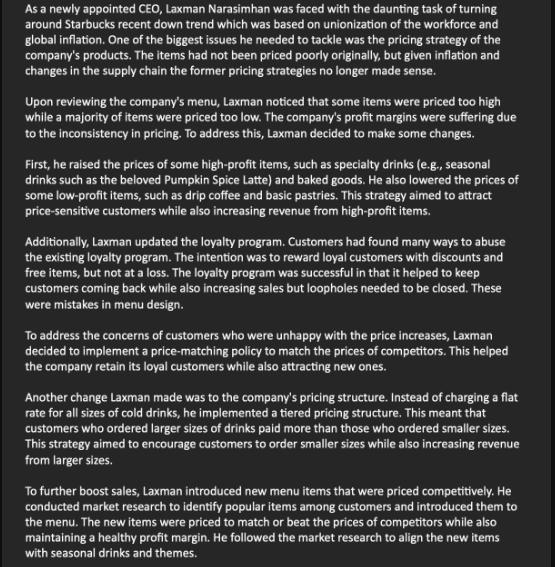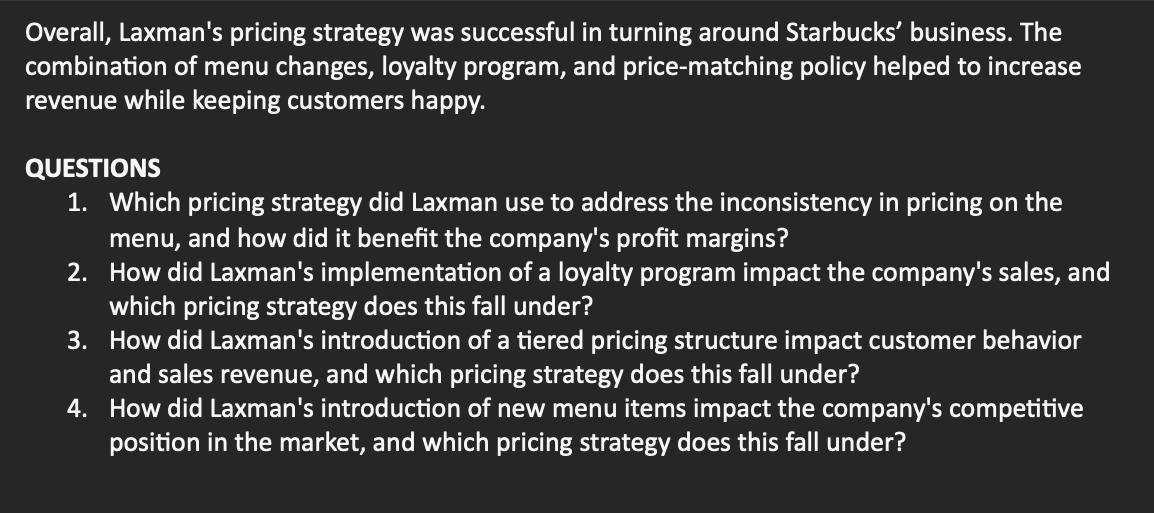Answered step by step
Verified Expert Solution
Question
1 Approved Answer
As a newly appointed CEO, Laxman Narasimhan was faced with the daunting task of turning around Starbucks recent down trend which was based on


As a newly appointed CEO, Laxman Narasimhan was faced with the daunting task of turning around Starbucks recent down trend which was based on unionization of the workforce and global inflation. One of the biggest issues he needed to tackle was the pricing strategy of the company's products. The items had not been priced poorly originally, but given inflation and changes in the supply chain the former pricing strategies no longer made sense. Upon reviewing the company's menu, Laxman noticed that some items were priced too high while a majority of items were priced too low. The company's profit margins were suffering due to the inconsistency in pricing. To address this, Laxman decided to make some changes. First, he raised the prices of some high-profit items, such as specialty drinks (e.g., seasonal drinks such as the beloved Pumpkin Spice Latte) and baked goods. He also lowered the prices of some low-profit items, such as drip coffee and basic pastries. This strategy aimed to attract price-sensitive customers while also increasing revenue from high-profit items. Additionally, Laxman updated the loyalty program. Customers had found many ways to abuse the existing loyalty program. The intention was to reward loyal customers with discounts and free items, but not at a loss. The loyalty program was successful in that it helped to keep customers coming back while also increasing sales but loopholes needed to be closed. These were mistakes in menu design. To address the concerns of customers who were unhappy with the price increases, Laxman decided to implement a price-matching policy to match the prices of competitors. This helped the company retain its loyal customers while also attracting new ones. Another change Laxman made was to the company's pricing structure. Instead of charging a flat rate for all sizes of cold drinks, he implemented a tiered pricing structure. This meant that customers who ordered larger sizes of drinks paid more than those who ordered smaller sizes. This strategy aimed to encourage customers to order smaller sizes while also increasing revenue from larger sizes. To further boost sales, Laxman introduced new menu items that were priced competitively. He conducted market research to identify popular items among customers and introduced them to the menu. The new items were priced to match or beat the prices of competitors while also maintaining a healthy profit margin. He followed the market research to align the new items with seasonal drinks and themes. Overall, Laxman's pricing strategy was successful in turning around Starbucks' business. The combination of menu changes, loyalty program, and price-matching policy helped to increase revenue while keeping customers happy. QUESTIONS 1. Which pricing strategy did Laxman use to address the inconsistency in pricing on the menu, and how did it benefit the company's profit margins? 2. How did Laxman's implementation of a loyalty program impact the company's sales, and which pricing strategy does this fall under? 3. How did Laxman's introduction of a tiered pricing structure impact customer behavior and sales revenue, and which pricing strategy does this fall under? 4. How did Laxman's introduction of new menu items impact the company's competitive position in the market, and which pricing strategy does this fall under?
Step by Step Solution
★★★★★
3.42 Rating (149 Votes )
There are 3 Steps involved in it
Step: 1
1 Laxman used a pricing strategy known as Price Optimization to address the inconsistency in pricing ...
Get Instant Access to Expert-Tailored Solutions
See step-by-step solutions with expert insights and AI powered tools for academic success
Step: 2

Step: 3

Ace Your Homework with AI
Get the answers you need in no time with our AI-driven, step-by-step assistance
Get Started


